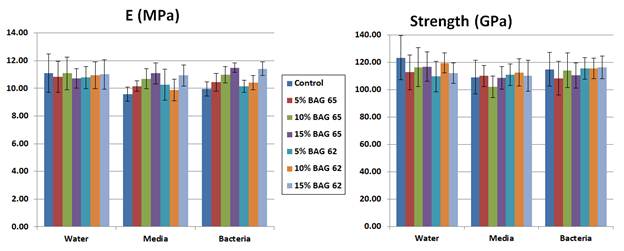The principal reason for replacement of dental composites is recurrent decay of the tooth due to bacterial colonization at the interface or below the restoration.
Objectives: In this project, we prepared novel dental polymer composite restorative materials containing sol-gel bioactive glasses (BAGs) as fillers. These BAGs may render the restoration more resistant to bacterial colonization via the demonstrated anti-bacterial effect of the BAG and the release of fluoride.
Methods: Two types of BAG were synthesized in our lab: 65 wt% silica - 31 wt% calcia - 4 wt% phosphate; and 61 wt% silica - 31 wt% calcia - 4 wt% phosphate - 4 wt% flouride. These were incorporated in three proportions (5, 10 and 15 wt%) along with silane-treated strontium glass into a 50:50 bisGMA/TEGDMA visible light-cured resin. Test bars for flexure testing (strength and E) in 3-point bending (25mm x 2mm x 2mm) were prepared. Composite containing the glass only (no BAG) served as a control. Test bars were aged for 24 hours in water, and for two months in a bacterial culture system of brain-heart infusion (BHI) media containing Streptococcus mutans (strain 25175), a known acid-producing microbe. Bars were also immersed in BHI without bacteria as a control. Samples were incubated at 37ēC, 5%CO2 and agitated daily; media was changed every other day. Bacterial growth and colonization of the bars was confirmed throughout the test period.
Results: Samples with BAG had comparable strength and flexural modulus to the control samples - no significant differences were seen after any of the treatments (ANOVA/Tukey's; α=0.05).
Conclusion: The inclusion of anti-bacterial BAG as a filler component did not diminish the initial strength or the stability over 2 months of these new composite materials, which may ultimately increase longevity and service life of dental composite restorations.
Keywords: Bacterial, Bioactive glass, Biomaterials, Composites and Dental materials
![[ Visit AADR's Website ]](images/banner.jpg)
